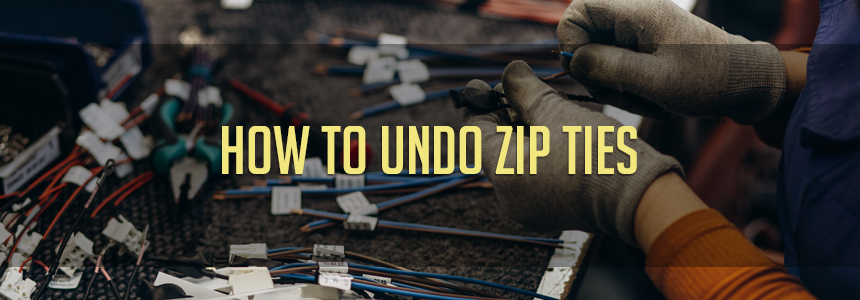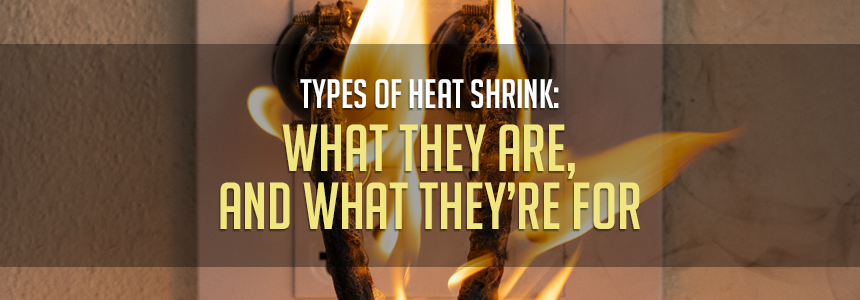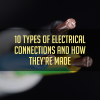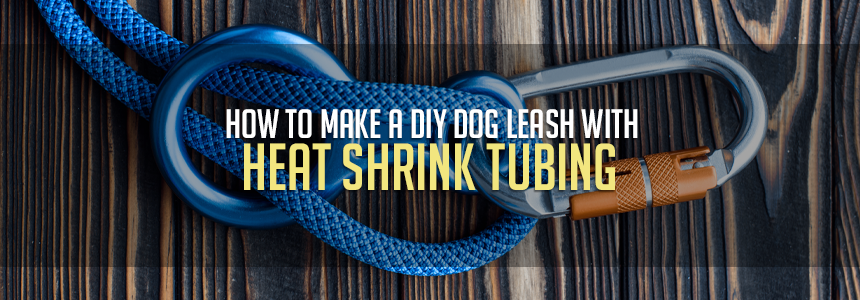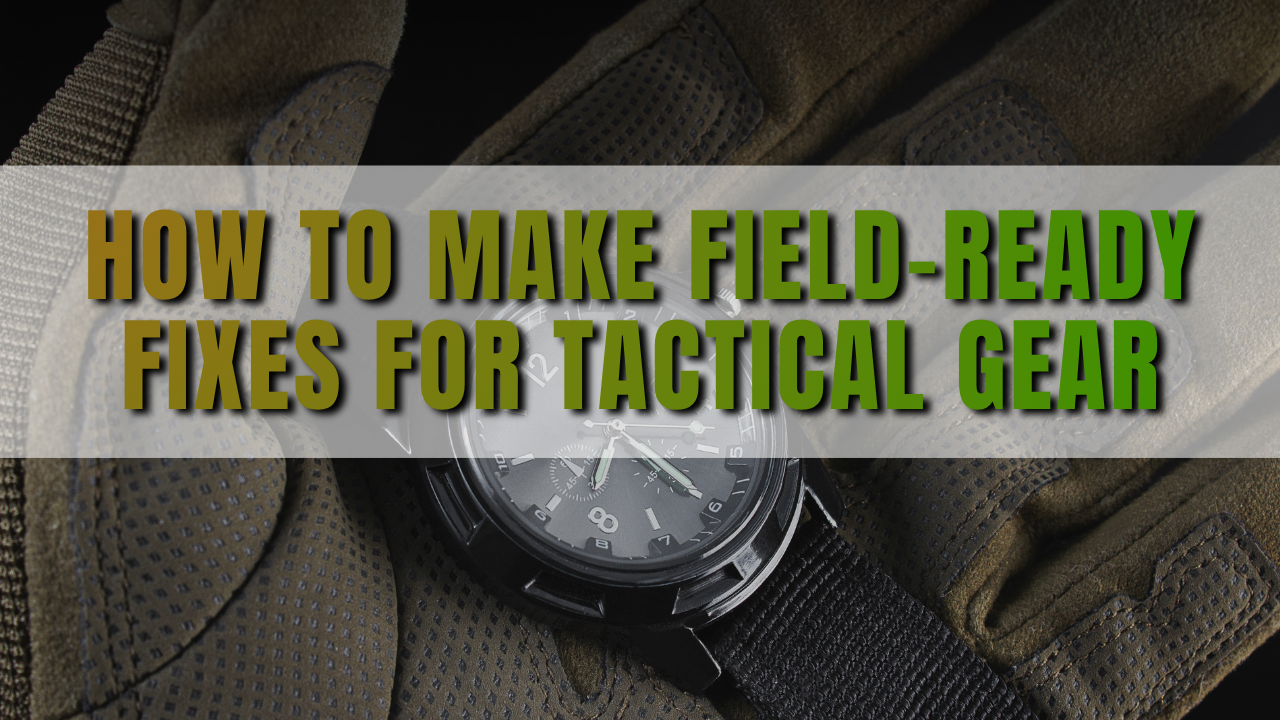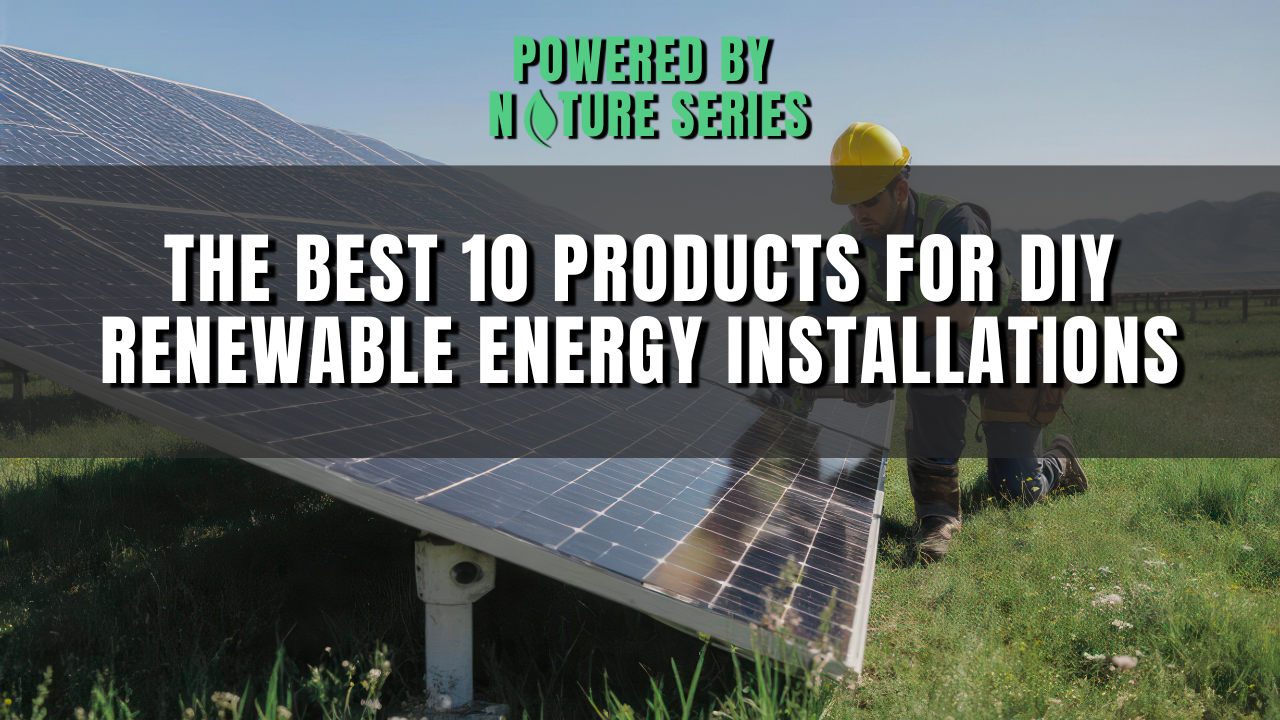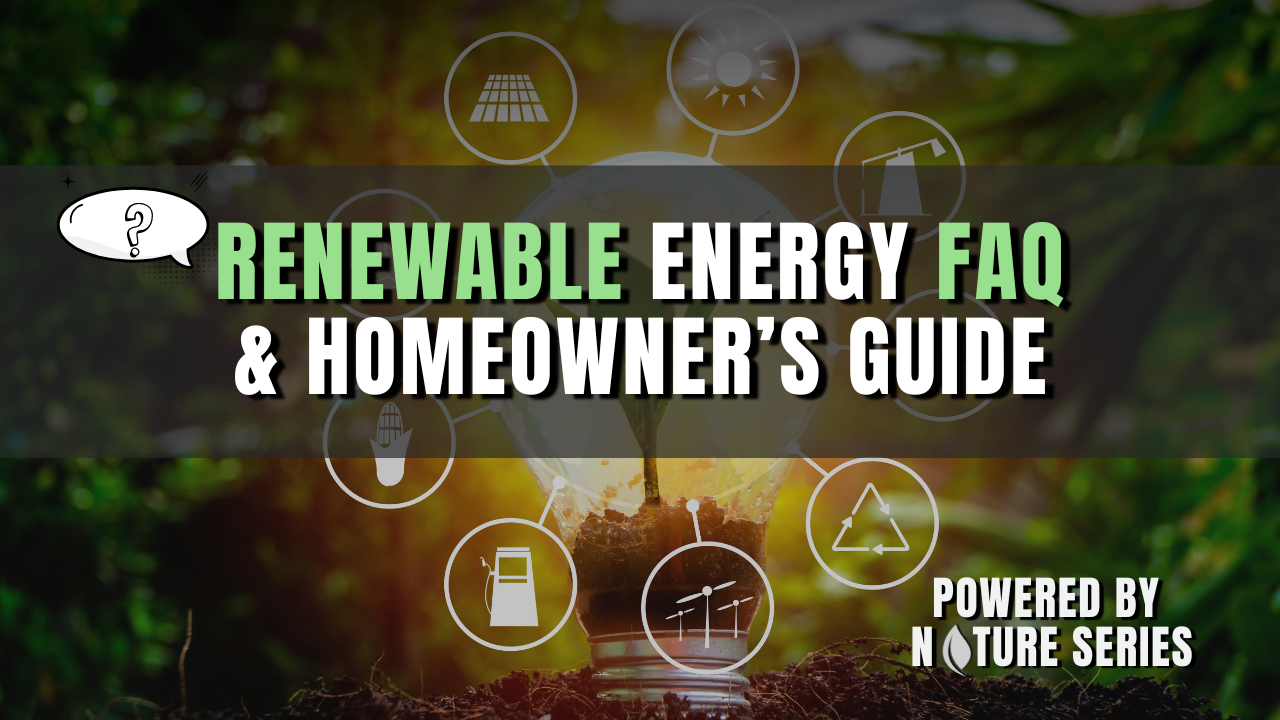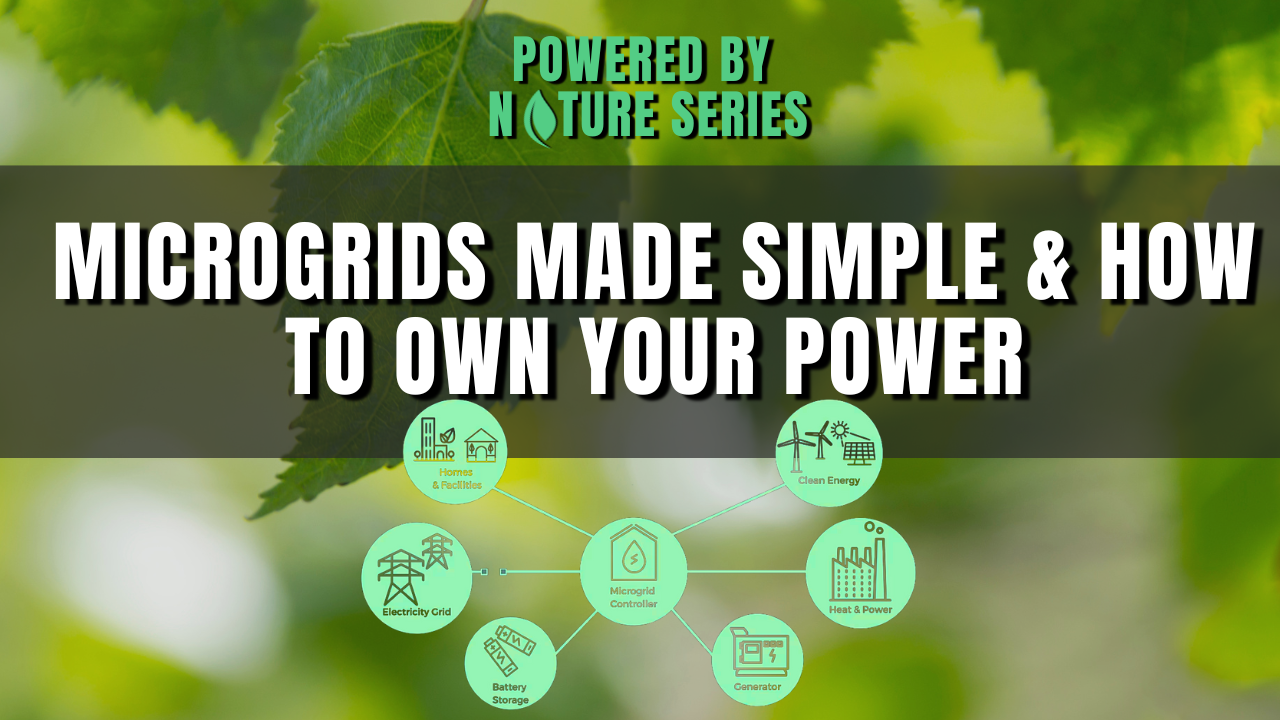
Powered By Nature: Microgrids Made Simple & How to Own Your Power
We were all born into someone else's power grid. But that's not where we have to stay.
Sunlight, wind, and water give us all access to renewable energy, and it's up for grabs. But it's not enough to install home solar panels or build a residential wind turbine.
Homeowners have to be ready to store what they generate and protect what's theirs.
If you want to pass on price spikes. If you want to break free from the big grid. If you want to keep the lights on at home, no matter what comes your way. If you want to shift from generation to ownership. If you want resilient power and sustainable freedom, you can DIY.
Then this third Powered By Nature blog is for you. Because microgrids are where the real autonomy lives.
Why Microgrids Matter, Benefits Beyond the Buzz
Why are microgrids so important for energy independence?
Because they aren't just about generating power. They're about controlling it, storing it, and using it when it matters most.
Microgrids give you power over your power. They are your own personal, local infrastructure. They turn your power generation tools (like home solar power or wind turbines) into a complete power system. They are the missing link between making clean energy and keeping the clean energy that you make.
Microgrids matter. And they've got the benefits to prove it:
- Keep what you generate by storing solar and wind energy so you stay powered up at night and beyond.
- Stay powered through outages with a system that keeps your home running even when the grid goes down.
- Stabilize utility bills by using stored energy during surge rates and selling excess when prices peak.
- Keep energy costs predictable while building a system that moves you closer to full self-sufficiency.
- Decide what gets powered and when with smart controls that prioritize loads and automate switching. (We love this one!)
- Grow as you go with a setup that's easy to scale across homes, cabins, workshops, outbuildings, and small businesses.
- Be ready for what's next with infrastructure that supports EVs, smart appliances, and future upgrades.
- DIY your own resilience with a protected system and the gear that makes energy independence possible for anyone willing to build.
With a microgrid, your residential renewable energy setup becomes a system—smart, scalable, and built to last. But microgrids all start with the renewable power you generate, which means you need to be generating it first.
So if you've been thinking about installing solar panels, building a microturbine, or going green energy at home, now's the time to start. And now's the time to build a microgrid to store, manage, and protect that energy.
Anatomy of a Microgrid
Microgrids are small, self-contained energy systems. They're not just one thing, but more like a compilation of working parts that turn your renewable energy into reliable power. Let's break it down.
- Power Generation: It all starts with solar panels, wind turbines, or both. These are your energy harvesters. The tools that capture sunlight and wind and kickstart your energy system.
- Inverter: These convert DC power (from solar/wind) into AC power that your home can actually use. Without this, your energy stays stuck in the wrong format.
- Battery Bank: Take home renewable energy to the next level with the ability to store excess energy. This gives you access to your electricity "after the fact". That way, when there's a storm or the sun is down, you'll have what you need because you stored what you made.
- Smart Controller (or EMS): These are the brains of the operation. The interface where you manage and monitor your system (some use apps). This helps you optimize the flow of your energy: when to store, when to sell, when to switch.
Microgrids are a group of interconnected loads and generation sources that are connected to the main electrical grid, but can operate independently of it. This lets you generate electricity on-site, use what you need, sell excess energy back, and draw power if needed.
At home, your power generation sources, like your solar panels, wind turbine, battery bank, or even your backup generator, are called Distributed Energy Resources (DERs). They're distributed (not centralized) near your home and where your energy is used. DERs are the fuel. The microgrid is the brain. Together, they create a system that saves money, boosts reliability, and makes smarter decisions than the grid ever could.
Wiring & Protection Essentials
And all those smart decisions your microgrid makes?
All that storing, distributing, using, drawing, selling, and managing? It's all possible because every part of your microgrid is connected to every other part.
It's all possible because of wires.
In a microgrid, wiring does more than just connect parts and transmit data. Microgrid wiring carries high-voltage power. It sits near heat-generating parts. It lives outdoors. It's exposed to moisture, vibration, and wear. Microgrids require wiring. And that wiring requires special protection for safety, longevity, performance, and peace of mind.
So let's walk through the protective gear you'll need, mapped to its real install points in your microgrid setup, because proper placement and protection keep you powered.
Connecting Your Battery Bank
Battery banks are your reserve tank. They are high-voltage, high-current, and high-risk if left exposed. Here you'll find incoming and outgoing wires plus busbars, interconnects, and monitoring wires.
- Start with heavy wall tubing to insulate battery leads and busbars. These thicker, heavier walls will give you some of the best dialectic insulation and electrical protection on the market. Plus, they're flame-retardant, abrasion-resistant, and built to handle high-current flow with long-term durability.
- Outdoor setups and fixed terminal points will benefit from adhesive lined heavy wall tubing. The adhesive layer seals out moisture and adds strain relief indefinitely. So if you need access to terminals or connection points, skip the waterproof adhesive and use an unlined heavy wall option.
- Cap off unused leads or unconnected ports with heat shrink end caps. These keep water, dust, and debris at bay. Open conductors are a hazard. Sealing them is smart, and sometimes it's required by code.
- Pro-tip: Outdoor install? Go waterproof with adhesive lining on any tubing product!
Wiring Your Inverter and Power Sources
This is where DC becomes AC. Your inverter is the bridge between raw generation and usable power. It's also where heat, vibration, and voltage spikes converge. Solar panels, wind turbines, and backup generators all feed into this point. If your wiring fails here, your whole system stalls.
- DIY residential microgrid installers will want adhesive lined heat shrink on their inverter leads and outputs. Solar panels, wind turbines, and inverter wiring use smaller gauge wires that don't need the extra-thick tubing that battery leads do.
- Using dual wall tubing provides mechanical protection and environmental sealing to solar panel leads and turbine wires, especially where they exit junction boxes or conduits in outside setups.
- Secure inverter wiring with high-temp cable ties. They don't sag, slack, warp, melt, or snap under thermal cycling. They won't degrade if used near hot parts, like fan-cooled compartments and heat sinks.
- Label your AC/DC transitions with heat shrink labels. This isn't just for neatness. It's for safe maintenance, code compliance, and future upgrades. When your system grows, clear labeling saves hours. We like custom printed heat shrink tubing for this!
- Pro-tip: If your inverter's mounted outside, even if it's enclosed like a shed, treat every wire like it's exposed. Moisture will find a way in. Protect now, before it's too late.
Organizing Your Smart Controller/EMS
This is the brain and logic layer of your microgrid. Here you'll find control wiring, data lines, low-voltage circuits, and sensory inputs. And they're all routed through enclosures that demand airflow, clarity, and clean organization. Your smart controller can't make smart decisions if the wiring around it is a mess.
- Bundle control wires with braided sleeving. The sleeving expands and contracts to protect multiple wires at once from crushing, kinking, or tight corners. Its breathable, heat-dissipating weave allows airflow to sensitive parts. Sleeving keeps wires protected and grouped carefully so they don't get sucked into fan blades. It also offers future serviceability, because there's no heating or shrinking. Just thermal performance and protection where wiring is both dense and directional.
- Use a cable tie assortment kit to secure, color-code, and route where space is tight, like an EMS cabinet. Tight, layered, low-voltage lines benefit from the control without construction in smaller, thinner cable ties. Nylon keeps them strong, rugged, and reliable, no matter how tiny they might be. Use intermediate sizes for sensor wires, data cables, and delicate routing paths.
- Use heat shrink labels to tag battery strings, load priorities, and control circuits. This makes your system readable, maintainable, and compliant. When it's time for upgrades or expansions, labeled wiring is the difference between clarity and chaos. Not up for custom printing? Try Write-on and Flag cable ties to bundle and label all-in-one.
- Pro-tip: If your EMS has app-based monitoring, label the physical circuits to match your digital dashboard. It's a small step that saves big confusion.
Tools That Work Smarter, Not Harder
Protecting your gear only works if it's installed correctly. These tools turn the average DIY setup into a professional-grade system. They offer you easy ways to go from "good enough" to "built to last". They're convenient, consistent, and precise, allowing you to give every piece and part of your microgrid the attention it deserves.
- Use a bench mount hot knife cutter for the cleanest, most fray-free sliced sleeving possible. Frayed ends, cut with scissors, lead to weak points, water ingress, and slippage. A hot knife gives you clean cuts that hold up under movement and airflow.
- Apply even, error-free heat with a heat gun. These versatile little hot air tools take all the guesswork out of heat shrink tubing installations. They work carefully and closely in compact spaces with specialty deflectors made to install heat shrink in seconds.
- Print clear, durable labels with a heat shrink label maker/printer. Your system will be readable, maintainable, and ready for inspection or expansion. Cheap stickers fade, peel, and smear. But heat shrink labels stay put and make your install safer, cleaner, and easier to install now…and troubleshoot five years from now.
Microgrids don't exist, function, or perform without wires. Well-maintained, clearly labeled, amply protected, thoroughly insulated, and inherently safe wires are the goal. And those wires are possible, with the right gear.
Trusted Products, Trusty Microgrids
We understand that not all products are created equal. Just like not all grids are created equal. So when you're ready to build the kind of autonomy you can trust, you need materials that match your intent. Durable. Compliant. Long-lasting. Reliable.
At Buyheatshrink.com, we prioritize materials that meet the demands of real-world installs. That's why our tubing holds up under heat, vibration, and time. Our labeling stays legible through seasons and upgrades. And our products meet the standards professionals trust: UL, CSA, MIL-SPEC, RoHS, REACH, and beyond.
We support your installations, intentions, and energy independence. We support the ideas and the ideals you have for the future—clean, green, and renewable. We support you.
- For off-grid dreamers, practical preppers, and homeowners who prefer freedom over uncertainty.
- For backyard tinkerers, clean energy champions, and home energy architects.
- For all those who believe resilience starts at home.
And for everyone who knows energy is a choice.
Powered by nature is your answer. From the soft sunlight filtering through the trees to the gentle wind rustling its leaves. Nature knows a better way. A better choice. A better future.
Where we all use, share, and properly manage the planet we have and the renewable energy we have access to. Are you ready to take back your power?
Gear up. Join the movement. Power your independence with Buyheatshrink.com.
Powered By Nature: Microgrids Made Simple & How to Own Your Power





